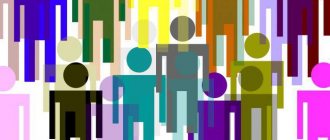What is the social essence of man?
Social essence is a person’s ability to control his instincts, suppress and regulate his desires, engage in meaningful and purposeful activities, and comply with the rules accepted in society. Social essence determines our behavior and the types of activities that we allow ourselves in everyday life.
Among the many biological species inhabiting our planet, man stands out precisely because of his social essence. Of course, many animals also unite in packs and other communities, but they do this under the influence of instincts. People, on the contrary, are able to overcome instincts to fulfill their social roles.
As examples of the manifestation of a person’s social essence, the following can be noted:
- overcoming primitive instincts and “primitive feelings”;
- desire to change the world for the better;
- the need for active activity that is useful for society;
- the ability to improve and overcome one’s weaknesses;
- the ability and need to set goals and achieve them;
- the need for communication and other forms of interaction;
- need for recognition and respect.
If you look at Maslow's pyramid, you will notice that the first two levels are related to the satisfaction of basic biological needs. But the levels located above reflect various aspects of a person’s social essence.
Maturity
Social maturity is the ability of a person living in society to take responsibility and make decisions.
A mature person is characterized by integrity of character, predictability, and positive behavior.
A mature person is always clearly aware of his goals and strives to achieve them, without violating the interests of other members of society. Such people evaluate themselves and the people around them extremely objectively and make decisions in accordance with the circumstances.
Achieving social maturity does not eliminate the need for other people . A mature person continues to learn new experiences, reconsider his views and work on himself throughout his life. But other people for him are advisers and interlocutors, and not teachers and mentors.
Differences between social essence and biological
As we have already found out, man is a biosocial being with a dual nature. The biological essence, which is the result of evolution, is combined in it with the social essence - the product of the development of society. They both have a significant impact on all aspects of human life and behavior. Moreover, each of them has certain features:
- The biological essence is manifested in the fact that a person is an ordinary animal with his own needs and instincts aimed at their realization. The basic biological needs of humans are the maintenance of life, reproduction and protection of offspring.
- The social essence is manifested in the fact that a person, being part of society, is able to control his instincts, suppress and regulate his desires, engage in meaningful and purposeful activities, and follow the rules. Social essence, like personality, is formed in the process of socialization.
Different authors speak differently about the relationship between the biological and social essences of man. Some contrast them, while others consider them closely related. The second point of view is more popular. It implies that a person has a biological essence from birth, but as he grows up and socializes, the social one plays an increasingly important role. At the same time, it is also aimed at realizing human needs, but through adaptation to the complex requirements of human society.
E. Erikson's theory of psychosocial development
E. Erikson argued that a person develops throughout his life.
From birth to death, it goes through 8 stages, each of which is accompanied by a certain crisis :
- infancy (0-1 year);
- early childhood (1-3 years);
- childhood (3-6 years);
- school age (6-12 years);
- adolescence and youth (12-20 years);
- early maturity (20-25 years);
- middle age (25-65 years);
- late maturity (after 65 years).
Every crisis can end well or negatively .
If a person successfully overcomes it, then he moves on to the next stage of life with good prerequisites for further personal development.
If the crisis is not overcome, then the transition to the next level still occurs, but unresolved problems at the new level remain with the person.
The formation of the social essence of man
You've probably heard the saying, "Work made a man out of a monkey." So it's not as meaningless as it seems. Indeed, labor aimed at satisfying one’s own needs and the needs of one’s tribe played a significant role in the transformation of man into a social being. Collaborative labor represented historically the first form of social interaction between people.
Initially, people engaged in joint production - hunting and gathering, then they learned to jointly grow crops and engage in other forms of production. With the advent of material values, which did not arise on their own, but were produced by people, such concepts as property and power began to form.
Over time, social interaction between people in the same tribe, as well as between neighboring tribes, became increasingly diverse. In particular, people realized that they could not only own resources, but also exchange them for those that were needed at the moment. Paleontologists say that people learned to trade and exchange during a period called the “Neolithic Revolution.” It is this event that can be considered the moment of formation of the social essence of man.
Part B
1 Write down the word missing in the table.
Q 2. Choose a concept that is generalizing for all other concepts in the series below, and write down the number under which it is indicated.
1) objects of activity 2) results of activity 3) motives of activity 4) goals of activity 5) structure of activity
B 3. Below is a list of terms. All of them, with the exception of two, characterize types of human knowledge.
1) scientific truths 2) folk wisdom 3) mythology 4) hypothesis 5) delusion 6) experiment
Find two terms that “fall out” from the general series and write down the numbers under which they are indicated in your answer.
B 4. Establish a correspondence between examples and elements of the activity structure
Q 5. Read the text below, in which a number of words are missing.
“Worldview is a system of generalized views on the world and the place _______________(A) in it, on the attitude of people to the reality around them and themselves, as well as the basic _______________(B) people determined by these views, their beliefs, ideals, principles of cognition and activity, value orientations. Worldview is not all views and _______________ (B) about the world around us, but only their utmost generalization. The content of the worldview is grouped around one or another decision of _______________(D) philosophy. The _______________(D) worldview is actually represented by the group and the individual. Worldview is the core of social and individual consciousness. Developing a worldview is a significant indicator of the maturity of not only an individual, but also a certain _______________(E), social class. In its essence, a worldview is a socio-political phenomenon that arose with the advent of human society.”
Select one word after another, mentally filling in each gap with words. Please note that there are more words in the list than you will need to fill in the blanks.
| 1) items | 2) subject | 3) social group |
| 4) life positions | 5 people | 6) reason |
| 7) abilities |  representation representation | 9) main question |
| A | B | IN | G | D | E |
Q 6. Read the text below, each position indicated by a letter.
(A) Truth is reliable, objective knowledge corresponding to knowable objects and phenomena. (B) It is obvious that a person strives to comprehend the truth primarily for utilitarian purposes, to obtain practical benefits. (B) Scientists obtain truth using special methods: empirical and theoretical. (D) On the path to understanding the laws of development of the universe, scientists should be especially responsible. (D) Paths of knowledge and methods of cognitive activity, without a doubt, must have moral restrictions and filters.
Determine which provisions of the text are
1) factual nature; 2) the nature of value judgments; 3) the nature of the theoretical positions.
Social personality traits
Personality is a concept that reflects the social nature of a person. That is, this is not just an individual, but a subject of social relations, a member of society, possessing a unique set of socially significant traits. In sociology there are two approaches to the study of personality:
- A person is considered as an active subject, capable of cognizing and changing the world around him, influencing society, assessing himself and his place in society. Within the framework of this approach, social qualities of a person are considered to be those qualities that determine a person’s lifestyle, his self-esteem and his assessment by other members of society.
- Personality is considered as a set of social functions and roles. A person simultaneously performs several functions in different areas of life. Within the framework of this approach, social qualities of an individual are qualities that are formed and developed in the process of interaction with other members of society.
Basic social qualities of a person:
- self-awareness – the ability to be aware of oneself, evaluate one’s actions and understand how others evaluate them;
- self-esteem is a complex characteristic that shows how a person perceives his abilities, capabilities and other characteristics;
- social identification – identification by a person with a certain social group;
- activity – the ability to perform socially significant actions, take initiative when interacting with others;
- interests are the source of motivation necessary for active actions;
- beliefs - moral, ideological, religious and other views that determine a person’s perception of the world around him;
- life goals are global goals that a person perceives as his destiny.
From a psychological point of view, the presence of life goals is a key characteristic of a mature personality . Despite all the variety of possible options, all existing life goals can be grouped into four groups:
- material goods and comfort;
- development and creative activity;
- power and respect;
- spiritual improvement.
Types
In modern science, it is customary to distinguish the following social personality types from the point of view of value orientations inherent in individuals:
- Traditionalists . For them, law-abidingness, diligence, discipline and responsibility come first. Similar traits are observed against the background of a lack of desire for self-realization and independence.
- Idealists . They are the exact opposite of traditionalists. They strive to prove themselves and act in accordance with their own attitudes and principles. They do not recognize authorities and traditional views on issues.
- Frustrated type . These people do not feel involved in public life or in making important public decisions. They are characterized by low self-esteem, a constant state of depression and passivity.
- Realists .
Such individuals competently combine the desire for self-realization with an awareness of a sense of duty. They are able to rationally approach problems and objectively assess the proposed circumstances. - Hedonistic materialists. They are typical consumers who strive for immediate pleasures without thinking about the future. Their own desires always come first for them.
Personality types:
Self-awareness and self-realization
Self-awareness and self-realization are important “building blocks” of a person’s social essence. Self-awareness is the ability of an individual to understand himself as a person, evaluate his capabilities and abilities, understand and predict how certain actions will be perceived by others, and also take responsibility for his own decisions and actions. It is self-awareness that determines how successfully a person can interact with other members of society.
Self-realization is the process of a person realizing his potential, achieving life and simply important goals. American psychologist Abraham Maslow believed that the need for self-realization is one of the highest human needs (along with self-actualization and self-development). He gave the following definition: self-realization is the fullest use of all talents, abilities and available opportunities to carry out personally significant activities.
Analysis Options
The socio-psychological parameters of personality analysis are as follows:
- Maturity . The highest level of maturity is the presence of certain life attitudes and views. A mature person is guided in his actions by an individual value system. He occupies a respected position in society and is an object to be emulated; he does not give up his views even under the threat of violence. Such a person can contribute to the development of other members of society who take their example from him. An immature personality is characterized by the absence of a clear value system and a low level of social responsibility.
- Adaptation .
This is the degree of adaptation of a person to the life of society. With conflict adaptation, non-acceptance of social norms occurs, which leads to psychological tension and difficulties with self-realization. With average adaptation, a person fully gets used to the surrounding reality and functions more or less successfully in society. With a high level of adaptation, the individual not only adapts to the surrounding reality, but also successfully develops in the proposed conditions. - Adequacy . This is the acceptance and assimilation by a person of the norms and principles existing in society. An individual does not simply externally adjust his behavior to generally accepted models, but internally transforms himself in the process of socialization. People who are adequate from a social point of view are distinguished by a high level of morality and ethics.
- Identity . This is the result of a person's self-identification. Having realized his “I”, an individual can compare the demands put forward by society and the opportunities provided with his abilities and desires. As a result, a mechanism for regulating behavior in society is developed, taking into account ideas about oneself.
Part C
C 5. What meaning do social scientists put into the concept of “personality”?
Using knowledge from the social science course, compose two sentences containing information about the individual.
C 6. Name any two differences between scientific knowledge and everyday (ordinary) knowledge and illustrate each of these differences with an example.
From 7. In the process of preparing for admission to a technical university, a high school student uses textbooks and manuals, solves many problems in mathematics and physics, and participates in olympiads.
In this example, highlight the subject and object, goals and means of activity. What type of activity can this activity be classified as? Explain your answer.
1. Personality, unlike the individual, has
1) rational thinking
2) articulate speech
3) the ability to make moral choices
4) sensory knowledge
2. Properties that reflect the biological nature of a person include
1) the ability to create new tools
2) communication using articulate speech
3) the ability to think abstractly
4) possessing the instinct of self-preservation
3. Man is a unity of three components: biological, psychological and social. The biological component includes
1) structural features of the human body 2) knowledge and skills
3) value orientations 4) behavioral skills
4. To characterize a person as a subject of social relations in science, the concept is used
1) individual 2) personality 3) citizen 4) individuality 5. What trait is common to both humans and animals?
1) ability to set goals
2) presence of psyche
3) following norms of behavior
4) accumulation of knowledge
6. A distinctive feature of the concept “personality” is(are)
1) articulate speech
2) presence of physical needs
3) the ability to take responsibility
4) consciousness and thinking
7. What type of knowledge includes laws, principles, concepts, concepts?
1) everyday experience 2) theoretical knowledge
3) folk wisdom 4) artistic image
8. Absolute truth, as opposed to relative
1) obtained only scientifically
2) is comprehensive knowledge about the subject
3) requires effort to understand
4) contains objective knowledge about the subject 9. Both absolute and relative truth
1) contains objective knowledge about the subject
2) obtained only scientifically
3) can never be refuted
4) is comprehensive knowledge about the subject
10. True knowledge
1) usually practically applicable 2) can only be obtained by science
3) corresponds to the subject of knowledge 4) is always presented in the form of a theory
11. Relative truth, as opposed to absolute
1) is a product of human cognitive activity
2) includes only empirically verified data
3) is distinguished by theoretical validity and evidence
4) represents incomplete reliable knowledge
12. Artistic (aesthetic) knowledge is based on
1) putting forward scientific hypotheses
2) generalization of data obtained experimentally
3) accumulation and generalization of life experience 4) display of the world in artistic images
13. Which of the following characterizes the theoretical level of knowledge?
1) conducting a scientific experiment
2) description of scientific facts
3) generalization of the data obtained
4) observation of individual facts and phenomena
14. Are the following judgments about human freedom true?
A.
Human freedom presupposes the possibility of realizing one’s interests and needs.
B.
The only limitation on a person's freedom is his moral principles.
1) only A is true 2) only B is true 3) both judgments are correct 4) both judgments are incorrect 15. Are the following judgments about the differences between humans and animals true?
A.
Man differs from animals in his ability to transform the environment through his work.
B.
Man differs from animals in his ability to think.
1) only A is true 2) only B is true 3) both judgments are correct 4) both judgments are incorrect
16. What feature distinguishes labor activity from other types of human activity?
1) communication and interaction with partners
2) the presence of an imaginary setting
3) perception of new information about the world
4) satisfaction of material needs
17. Citizen V. really likes to go to the food market near her house. She has long conversations on various topics with sellers. Meanwhile, food for the family is usually purchased by her husband at the supermarket. What needs are primarily realized in the actions of citizen V.?
1) aesthetic 2) ideal 3) economic 4) social
18. Sociological scientists interviewed a group of citizens of different ages, conducting a study on the sources of knowledge acquired by people.
Respondents (citizens participating in the survey) were asked to choose the correct continuation of the phrase from their point of view: “Most of the knowledge we acquire throughout our lives is based on...” The results (in%) presented in the diagram were obtained.
1) respondents believe that scientific research provides more knowledge than life experience 2) the largest percentage of respondents believe that human knowledge is mainly based on life experience
3) folk wisdom, according to a third of respondents, enriches us with knowledge
4) the smallest percentage of respondents spoke in favor of divine revelation as the main source of knowledge
19. True knowledge, as opposed to false,
1) is based on trust in the authority of great scientists
2) is the result of observation
3) corresponds to the subject of knowledge
4) describes the object and phenomena









